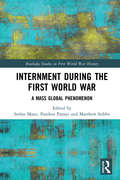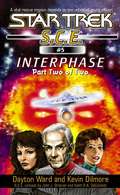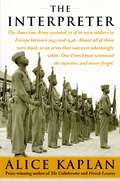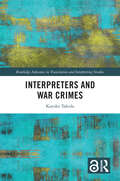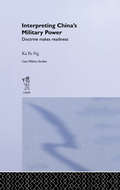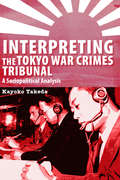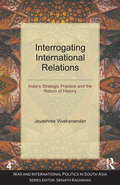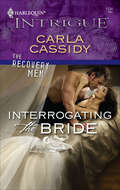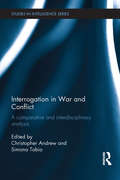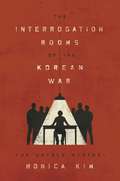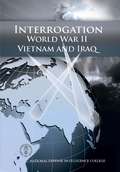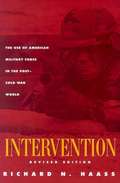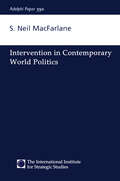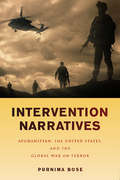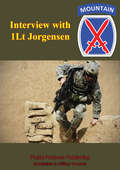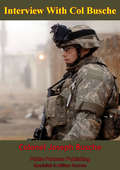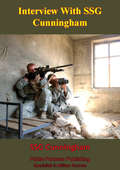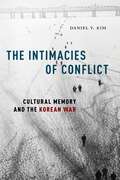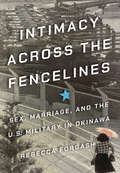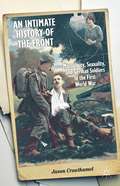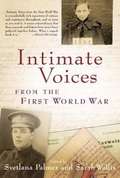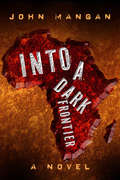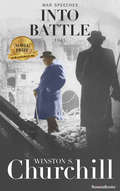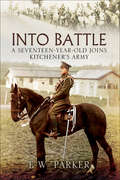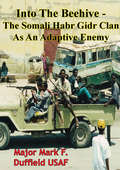- Table View
- List View
Internment during the First World War: A Mass Global Phenomenon (Routledge Studies in First World War History)
by Panikos Panayi Matthew Stibbe Stefan ManzAlthough civilian internment has become associated with the Second World War in popular memory, it has a longer history. The turning point in this history occurred during the First World War when, in the interests of ‘security’ in a situation of total war, the internment of ‘enemy aliens’ became part of state policy for the belligerent states, resulting in the incarceration, displacement and, in more extreme cases, the death by neglect or deliberate killing of hundreds of thousands of people throughout the world. This pioneering book on internment during the First World War brings together international experts to investigate the importance of the conflict for the history of civilian incarceration.
Interphase Book 2
by Dayton Ward Kevin DilmoreWith Captain David Gold and an away team trapped on the other side of an interdimensional rift, Lieutenant Commander Kieran Duffy Þnds himself in command of the U.S.S. da Vinci just as the ship comes under attack by the Tholians. The enemy is armed with a new and improved version of their infamous energy web, and the da Vinci is badly outnumbered, but þeeing the battle means abandoning the captain and the others to an uncertain fate outside this universe. There, marooned aboard a derelict vessel, Gold and his S.C.E. team struggle to keep the madness -- inducing effect of the rift from driving them to suicide and murder before they can Þnd a way to escape the realm of Interphase. The exciting conclusion of an all-new two-part adventure!
The Interpreter
by Alice KaplanNo story of World War II is more triumphant than the liberation of France, made famous in countless photos of Parisians waving American flags and kissing GIs, as columns of troops paraded down the Champs Élysées. Yet liberation is a messy, complex affair, in which cultural understanding can be as elusive as the search for justice by both the liberators and the liberated. Occupying powers import their own injustices, and often even magnify them, away from the prying eyes of home. One of the least-known stories of the American liberation of France, from 1944 to 1946, is also one of the ugliest and least understood chapters in the history of Jim Crow. The first man to grapple with this failure of justice was an eyewitness: the interpreter Louis Guilloux. Now, in The Interpreter, prize-winning author Alice Kaplan combines extraordinary research and brilliant writing to recover the story both as Guilloux first saw it, and as it still haunts us today. When the Americans helped to free Brittany in the summer of 1944, they were determined to treat the French differently than had the Nazi occupiers of the previous four years. Crimes committed against the locals were not to be tolerated. General Patton issued an order that any accused criminals would be tried by court-martial and that severe sentences, including the death penalty, would be imposed for the crime of rape. Mostly represented among service troops, African Americans made up a small fraction of the Army. Yet they were tried for the majority of capital cases, and they were found guilty with devastating frequency: 55 of 70 men executed by the Army in Europe were African American -- or 79 percent, in an Army that was only 8.5 percent black. Alice Kaplan's towering achievement in The Interpreter is to recall this outrage through a single, very human story. Louis Guilloux was one of France's most prominent novelists even before he was asked to act as an interpreter at a few courts-martial. Through his eyes, Kaplan narrates two mirror-image trials and introduces us to the men and women in the courtrooms. James Hendricks fired a shot through a door, after many drinks, and killed a man. George Whittington shot and killed a man in an open courtyard, after an argument and many drinks. Hendricks was black. Whittington was white. Both were court-martialed by the Army VIII Corps and tried in the same room, with some of the same officers participating. Yet the outcomes could not have been more different. Guilloux instinctively liked the Americans with whom he worked, but he could not get over seeing African Americans condemned to hang, Hendricks among them, while whites went free. He wrote about what he had observed in his diary, and years later in a novel. Other witnesses have survived to talk to Kaplan in person. In Kaplan's hands, the two crimes and trials are searing events. The lawyers, judges, and accused are all sympathetic, their actions understandable. Yet despite their best intentions, heartbreak and injustice result. In an epilogue, Kaplan introduces us to the family of James Hendricks, who were never informed of his fate, and who still hope that his remains will be transferred back home. James Hendricks rests, with 95 other men, in a U.S. military cemetery in France, filled with anonymous graves.
Interpreters and War Crimes (Routledge Advances in Translation and Interpreting Studies)
by Kayoko TakedaTaking an interdisciplinary approach, this book raises new questions and provides different perspectives on the roles, responsibilities, ethics and protection of interpreters in war while investigating the substance and agents of Japanese war crimes and legal aspects of interpreters’ taking part in war crimes. Informed by studies on interpreter ethics in conflict, historical studies of Japanese war crimes and legal discussion on individual liability in war crimes, Takeda provides a detailed description and analysis of the 39 interpreter defendants and interpreters as witnesses of war crimes at British military trials against the Japanese in the aftermath of the Pacific War, and tackles ethical and legal issues of various risks faced by interpreters in violent conflict. The book first discusses the backgrounds, recruitment and wartime activities of the accused interpreters at British military trials in addition to the charges they faced, the defence arguments and the verdicts they received at the trials, with attention to why so many of the accused were Taiwanese and foreign-born Japanese. Takeda provides a contextualized discussion, focusing on the Japanese military’s specific linguistic needs in its occupied areas in Southeast Asia and the attributes of interpreters who could meet such needs. In the theoretical examination of the issues that emerge, the focus is placed on interpreters’ proximity to danger, visibility and perceived authorship of speech, legal responsibility in war crimes and ethical issues in testifying as eyewitnesses of criminal acts in violent hostilities. Takeda critically examines prior literature on the roles of interpreters in conflict and ethical concerns such as interpreter neutrality and confidentiality, drawing on legal discussion of the ineffectiveness of the superior orders defence and modes of individual liability in war crimes. The book seeks to promote intersectoral discussion on how interpreters can be protected from exposure to manifestly unlawful acts such as torture.
Interpreting China's Military Power: Doctrine Makes Readiness (Cass Military Studies)
by Ka Po NgAlthough inter-state tensions have generally been easing after the Cold War, military power remains a dominant factor in Asian regional politics. As China, operating the world's largest army, grows stronger, there are ongoing debates over the implications for Asia's regional security. This book argues that it is imperative to look beyond the empirical observations and conventional materialist reading of Chinese military development to understand its dynamics and directions in doctrinal terms and put it in a readiness context for evaluation. Military doctrine has long been under-studied and is often treated as a subject separate from force development. But, as this study contends, this factor is necessary for interpreting the making and purposes of China's military power because it forms the intellectual foundation of military structural and hardware development. When loaded with political rhetoric, it also communicates to us the intended uses of the military power. The role of doctrine is reinforced in the context of military readiness, which defines what for and how the army is getting ready. Force development is evaluated in structural, operational and directional terms.The importance of this analytical framework based on military doctrine and readiness is demonstrated in a survey of the evolutionof Chinese military doctrine and force development. As the Chinese People's Liberation Army has continued to adjust its military structure and operation to follow the doctrinal lead, its switches between the doctines of local war and total war have seen corresponding changes to the emphasis between operational and structural readiness.
Interpreting the Tokyo War Crimes Tribunal: A Sociopolitical Analysis (Perspectives on Translation)
by Kayoko TakedaIn order to ensure its absolute authority, the Tokyo War Crimes Tribunal (1946–1948), the Japanese counterpart of the Nuremberg Trial, adopted a three-tier structure for its interpreting: Japanese nationals interpreted the proceedings, second-generation Japanese-Americans monitored the interpreting, and Caucasian U.S. military officers arbitrated the disputes. The first extensive study on the subject in English, this book explores the historical and political contexts of the trial as well as the social and cultural backgrounds of the linguists through trial transcripts in English and Japanese, archival documents and recordings, and interviews with those who were involved in the interpreting. In addition to a detailed account of the interpreting, the book examines the reasons for the three-tier system, how the interpreting procedures were established over the course of the trial, and the unique difficulties faced by the Japanese-American monitors. This original case study of the Tokyo War Crimes Tribunal illuminates how complex issues such as trust, power, control and race affect interpreting at international tribunals in times of conflict.
Interrogating International Relations: India's Strategic Practice and the Return of History (War and International Politics in South Asia)
by Jayashree VivekanandanThe book interrogates the disciplinary biases and firewalls that inform mainstream international relations today, and problematises the several tropes that have come to typify the strategic histories of post-colonial societies such as India. Questioning a range of long-held cultural representations on India, the book challenges such portrayals and underscores the centrality of context and contingency in any cultural explanation of state behaviour. It argues for a historico-cultural understanding of power and critiques IR’s tendency to usher in a selective ‘return of history’. Taking two contrasting case studies from medieval Indian history, the book assesses the success and failure of the grand strategy pursued by the Mughal empire under Akbar. The study emphasises his grand strategy of accommodation, defined by the interplay of critical variables such as distance and the vast military labour market. The book also looks at his conscious attempt to indigenise power by projecting himself as the personification of the ideal Hindu king. This case study helps to contextualise the many critical transitions that occurred in international relations: from medieval empires to the modern state system, and from an indigenised, experiential understanding of power to its absolute, abstract manifestations in the colonial state.
Interrogating the Bride (The Recovery Men #1)
by Carla CassidyFormer navy SEAL Micah Stone could spot danger a mile away. And the alluring bride who'd stowed away on the plane he'd been sent to repossess set off every red flag in the book. Caylee Warren claimed she had nothing to do with her "fiancé's" murder. When it began to look as if Caylee was the intended victim, Micah had no choice but to take her into hiding. But for a man who never let anyone get close, protecting Caylee was more than he could handle. Could he let her break down the walls he'd erected around his heart...even if it meant distracting him from the mission at hand?
Interrogation in War and Conflict: A Comparative and Interdisciplinary Analysis (Studies in Intelligence)
by Christopher Andrew Simona TobiaThis edited volume offers a comparative and interdisciplinary analysis of interrogation and questioning in war and conflict in the twentieth century. Despite the current public interest and its military importance, interrogation and questioning in conflict is still a largely under-researched theme. This volume’s methodological thrust is to select historical case studies ranging in time from the Great War to the conflicts in former Yugoslavia, and including the Second World War, decolonization, the Cold War, the ‘Troubles’ in Northern Ireland and international justice cases in The Hague, each of which raises interdisciplinary issues about the role of interrogation. These case-studies were selected because they resurface previously unexplored sources on the topic, or revisit known cases which allow us to analyse the role of interrogation and questioning in intelligence, security and military operations. Written by a group of experts from a range of disciplines including history, intelligence, psychology, law and human rights, Interrogation in War and Conflict provides a study of the main turning points in interrogation and questioning in twentieth-century conflicts, over a wide geographical area. The collection also looks at issues such as the extent of the use of harsh techniques, the value of interrogation to military intelligence, security and international justice, the development of interrogation as a separate profession in intelligence, as well as the relationship between interrogation and questioning and wider society. This book will be of much interest to students of intelligence studies, strategic studies, counter-terrorism, international justice, history and IR in general.
The Interrogation Rooms of the Korean War: The Untold History
by Monica KimA groundbreaking look at how the interrogation rooms of the Korean War set the stage for a new kind of battle—not over land but over human subjectsTraditional histories of the Korean War have long focused on violations of the thirty-eighth parallel, the line drawn by American and Soviet officials in 1945 dividing the Korean peninsula. But The Interrogation Rooms of the Korean War presents an entirely new narrative, shifting the perspective from the boundaries of the battlefield to inside the interrogation room. Upending conventional notions of what we think of as geographies of military conflict, Monica Kim demonstrates how the Korean War evolved from a fight over territory to one over human interiority and the individual human subject, forging the template for the US wars of intervention that would predominate during the latter half of the twentieth century and beyond.Kim looks at how, during the armistice negotiations, the United States and their allies proposed a new kind of interrogation room: one in which POWs could exercise their “free will” and choose which country they would go to after the ceasefire. The global controversy that erupted exposed how interrogation rooms had become a flashpoint for the struggles between the ambitions of empire and the demands for decolonization, as the aim of interrogation was to produce subjects who attested to a nation’s right to govern. The complex web of interrogators and prisoners—Japanese-American interrogators, Indian military personnel, Korean POWs and interrogators, and American POWs—that Kim uncovers contradicts the simple story in US popular memory of “brainwashing” during the Korean War.Bringing together a vast range of sources that track two generations of people moving between three continents, The Interrogation Rooms of the Korean War delves into an essential yet overlooked aspect of modern warfare in the twentieth century.
Interrogation World War II, Vietnam, And Iraq: World War Ii, Vietnam, And Iraq
by James A. Stone David P. Shoemaker Major Nicholas R. DottiIn September 2004, the Intelligence Science Board, an advisory board appointed by the Director of National Intelligence, initiated the Study on Educing Information (EI). This study is an ongoing effort to review what is known scientifically about interrogation and other forms of human intelligence collection and to chart a path to the future.As part of our efforts, we have worked closely with faculty and students of the National Defense Intelligence College. The NDIC Press published Educing Information: Interrogation: Science and Art, Foundations for the Future, a book based on Phase I of the Study on EI. Three students, Special Agent James Stone, U.S. Air Force; Special Agent David Shoemaker, U.S. Air Force; and Major Nicholas Dotti, U.S. Army, completed master's thesis studies during Academic Year 2006-07 on topics related to interrogation. Each thesis is a remarkable and useful document.Special Agent Stone researched U.S. efforts during World War II to develop language and interrogation capacities to deal with our Japanese enemy. He found that military leaders, often working with civilian counterparts, created and implemented successful strategies, building on cultural and linguistic skills that substantially aided the war effort for the U.S. and its Allies.Special Agent Shoemaker studied the experiences of three successful interrogators during the Vietnam War. Like S/A Stone, S/A Shoemaker suggests that policymakers and practitioners have much to learn from professionals who served effectively for years in the field educing information. And like Stone, Shoemaker highlights the importance of a deep understanding of the language, psychology, and culture of adversaries and potential allies in other countries.
Intervention: The Use of American Military Force in the Post-Cold War World
by Richard N. HaassFirst published in 1994, this volume addresses the debate over US intervention around the world, including recent cases, the politics of force, learning from history, the future of intervention. An afterword addresses the use of force by the US since 1994. Appendices present relevant documents and remarks by such figures as Caspar Weinberger, Colin Powell, and Bill Clinton.
Intervention in Contemporary World Politics: Intervention In Contemporary World Politics (Adelphi series)
by Neil MacfarlaneExamines multilateral interventions in civil conflicts and the evolution of the role of such interventions in world politics. It focuses primarily on the Cold War and post-Cold War eras and the differences between them. It contests the notion that there is an emerging norm of humanitarian intervention in international politics, arguing that political interests remain essential to the practice of intervention.
Intervention Narratives: Afghanistan, the United States, and the Global War on Terror (War Culture)
by Purnima BoseIntervention Narratives examines the contradictory cultural representations of the US intervention in Afghanistan that help to justify an imperial foreign policy. These narratives involve projecting Afghans as brave anti-communist warriors who suffered the consequences of American disengagement with the region following the end of the Cold War, as victimized women who can be empowered through enterprise, as innocent dogs who need to be saved by US soldiers, and as terrorists who deserve punishment for 9/11. Given that much of public political life now involves affect rather than knowledge, feelings rather than facts, familiar recurring tropes of heroism, terrorism, entrepreneurship, and canine love make the war easier to comprehend and elicit sympathy for US military forces. An indictment of US policy, Bose demonstrates that contemporary imperialism operates on an ideologically diverse cultural terrain to enlist support for the war across the political spectrum.
Interview With 1LT Jorgensen (Eyewitness To Modern War #10)
by Douglas CubbisonDouglas Cubbison, the Command Historian for the 10th Mountain Division, conducted a series of interviews with the soldiers of the 10th Mountain Division in Afghanistan during January 2007, along with several additional interviews conducted in February 2007 at Fort Drum, New York. The interviews are fairly wide ranging in the topics covered but all center around one particularly memorable event for the soldier being interviewed, such as an ambush, a patrol, a firefight, a helicopter crash, or a hero ceremony. This transcript is from the interview with First Lieutenant Jorgensen, Bravo Troop, 3rd Squadron, 71st Cavalry, conducted on 22 January 2007 at Forward Operating Base Naray, Afghanistan.
Interview with Col. Joseph Buche - 101st Airborne Division (Eyewitness To Modern War #8)
by Dr Tom BruscinoHaving assumed command of 3rd Battalion, 187th Infantry Regiment, 101st Airborne Division on D-Day, 6 June 2003, Colonel Joseph Buche initially deployed around the Tall Afar border region before his unit redeployed on short notice to the Al Qaim area where it played a central role in the success of Operation Rifles Blitz...Alerted that 3-187 should be prepared for operations in Najaf or Karbala then Fallujah, the operation in and around the Iraqi-Syrian border town of Al Qaim came as a surprise. "It came out of the blue" said Buche. "I'd never heard of Husaybah or Al Qaim, Iraq." Iron Hammer - 3-187's piece of Rifles Blitz - proved challenging, including the move into a new area of operations and the inherent tensions between the missions assigned...He emphasized several factors which contributed to the success of Rifles Blitz, including the reliability of their interpreters, the integration of psychological operations and information operations into the unit's scheme of maneuver, the ability to mass a lot of soldiers on the ground, the capability of trusted staff officers, and the matching of unit missions with the personalities of unit commanders. The need to establish a position of strength visible to the Iraqi people, he insists, is an imperative for successfully dealing with the populace..."Part of what I wanted to do" Buche added, "was to let any bad guys know that hell was coming to breakfast." Looking back, he proudly boasts that the operation was so successful that the enemy simply failed to fight. "I didn't have a hard time with not having any firefights in that operation at all. I took pride in it because, to me, that was evidence that those company commanders and troopers out there had maneuvered so well that the enemy never found themselves in a position of advantage where they wanted to engage us."
Interview with SSG Cunningham - 10th Mountain Division (Eyewitness To Modern War #7)
by Douglas CubbisonA US Army master sniper in charge of a team of marksmen and forward observers of the 10th Mountain Division recounts his experiences of Afghanistan during Operation Enduring Freedom.
The Intimacies of Conflict: Cultural Memory and the Korean War
by Daniel Y. KimEnables a reckoning with the legacy of the Forgotten War through literary and cinematic works of cultural memoryThough often considered “the forgotten war,” lost between the end of World War II and the start of the Cold War, the Korean War was, as Daniel Y. Kim argues, a watershed event that fundamentally reshaped both domestic conceptions of race and the interracial dimensions of the global empire that the United States would go on to establish. He uncovers a trail of cultural artefacts that speaks to the trauma experienced by civilians during the conflict but also evokes an expansive web of complicity in the suffering that they endured.Taking up a range of American popular media from the 1950s, Kim offers a portrait of the Korean War as it looked to Americans while they were experiencing it in real time. Kim expands this archive to read a robust host of fiction from US writers like Susan Choi, Rolando Hinojosa, Toni Morrison, and Chang-rae Lee, and the Korean author Hwang Sok-yong. The multiple and ongoing historical trajectories presented in these works testify to the resurgent afterlife of this event in US cultural memory, and of its lasting impact on multiple racialized populations, both within the US and in Korea. The Intimacies of Conflict offers a robust, multifaceted, and multidisciplinary analysis of the pivotal—but often unacknowledged—consequences of the Korean War in both domestic and transnational histories of race.
Intimacy across the Fencelines: Sex, Marriage, and the U.S. Military in Okinawa
by Rebecca ForgashIntimacy Across the Fencelines examines intimacy in the form of sexual encounters, dating, marriage, and family that involve US service members and local residents. Rebecca Forgash analyzes the stories of individual US service members and their Okinawan spouses and family members against the backdrop of Okinawan history, political and economic entanglements with Japan and the United States, and a longstanding anti-base movement. The narratives highlight the simultaneously repressive and creative power of military "fencelines," sites of symbolic negotiation and struggle involving gender, race, and class that divide the social landscape in communities that host US bases.Intimacy Across the Fencelines anchors the global US military complex and US-Japan security alliance in intimate everyday experiences and emotions, illuminating important aspects of the lived experiences of war and imperialism.
An Intimate History of the Front: Masculinity, Sexuality, And German Soldiers In The First World War
by Jason CrouthamelThis eye-opening study gives a nuanced, provocative account of how German soldiers in the Great War experienced and enacted masculinity. Drawing on an array of relevant narratives and media, it explores the ways that both heterosexual and homosexual soldiers expressed emotion, understood romantic ideals, and approached intimacy and sexuality.
Intimate Voices from the First World War
by Sarah Wallis Svetlana PalmerIn the tradition of the work of Studs Turkel and Ken Burns' "The Civil War," this book is the companion volume to a major television series--a compelling, personal account of World War I and its devastating aftermath. Photos & maps throughout.
Into a Dark Frontier
by John Mangan"Into a Dark Frontier is cut from the same cloth as the best of Vince Flynn and Brad Thor."—James RollinsIn the near future, Africa collapses into an enormous failed state, leaving the continent lawless and severely depopulated. For most, the breakdown brings horror, but for others—the outcast, the desperate, the criminal, and the insane—it allows unparalleled opportunity: a new frontier of danger and unlimited possibility.In America, ex-Navy SEAL Slade Crawford, emotionally crippled after twenty years of front line combat, the dissolution of his marriage, and the accidental death of his son, is falsely accused of terrorism. Slade flees to Africa to build a new life and escape his past, but he is captured by an enigmatic American colonel, Gary Kraven, and blackmailed into tracking down a blood cult that is rampaging across the sub-Sahara. Struggling to stay alive and to free himself from Kraven’s grasp, Slade pursues the cult across the lawless African frontier. He soon learns that nothing is as it seems and that he is standing at the epicenter of a global struggle that will determine the course of history. Slade must decide whether to fight for his life or his honor—he can't have both.
Into Battle (Winston S. Churchill War Speeches #1)
by Winston S. ChurchillThis first volume of collected essays and journalism from the Nobel Prize–winning prime minister includes some of his most important WWII speeches. Legendary politician and military strategist Winston S. Churchill was a master not only of the battlefield, but of the page and the podium. Over the course of forty books and countless speeches, broadcasts, news items and more, he addressed a country at war and at peace, thrilling with victory but uneasy with its shifting role in global politics. In 1953, he was awarded the Nobel Prize for Literature for &“his mastery of historical and biographical description as well as for brilliant oratory in defending exalted human values.&” During his lifetime, he enthralled readers and brought crowds roaring to their feet; in the years since his death, his skilled writing has inspired generations of eager history buffs. Churchill was at his best when rallying Britons to the twin causes of war and justice, delivering inspiration and hope during the hard years of bombings, violence, sacrifice, and terror. This compilation, composed of speeches made in the early years of the war, contains some of his best. Profound words from famous speeches in this collection include: &“This was their finest hour;&” &“Never in the field of human conflict was so much owed, by so many, to so few;&” and &“I have nothing to offer but blood, toil, tears and sweat.&” Many decades after the end of the war, Churchill&’s words still have the power to stir the blood—and inspire the heart. A must-read for all WWII history fans.
Into Battle: A Seventeen-Year-Old Joins Kitchener's Army
by E.W. ParkerWritten well over ninety years ago while the experiences of youth were still fresh in the authors mind, this is the story of a seventeen-year-old boy from the time he joined Kitcheners Army, as one of the first hundred thousand in 1914, until he found himself in hospital—an officer with the Military Cross—recovering from his last wound, on the day of the Armistice, 11 November, 1918.In no way a formal record of the great and terrible events it describes, this is a purely personal, almost private, account. It is a plain, unvarnished tale—and even more effective for that—of heroism, and the horror peculiar to trench warfare of the First World War.Interspersed with moments of pity, humor and a deep response to natural beauty and peace out of the firing line, it is a record, which in its details, direct simplicity and manner of telling, comes nearer to the truth than many more ambitious accounts.
Into The Beehive - The Somali Habr Gidr Clan As An Adaptive Enemy
by Major Mark F. Duffield USAFOn October 3rd 1993, US efforts in Somalia culminated as the result of an overnight battle that cost eighteen American lives and effectively silenced all optimism that Somalia could be externally resurrected as a functioning state. What began as a humanitarian mission to abate starvation had evolved into the absurdity of outright combat against the very people meant to be saved. Beyond the issues of political policy, lurks a disturbing fact that remains unaddressed by the US military. Out of the anarchy that was Somalia in 1993--and is like many other places where US forces may be, committed--an untrained, ill-equipped, and undisciplined enemy quickly adapted their tactics, invalidated key US planning assumptions, and evolved into a lethal force. The Habr Gidr's tactical adaptation outpaced the planning efforts of elite US units and achieved their tactical, operational and strategic goals at US expense.This monograph explores how this adaptation occurred. It goes beyond the common theories concerning equipment, tactics, and the inherent difficulties of combined operations to look at the very nature of adaptation itself. It provides a different view of events in Somalia in hopes of better informing military planners facing a similar opponent. At its heart, this monograph explores the possibility that what appeared to be little more than an anarchic mob may have been a functioning complex adaptive system.
